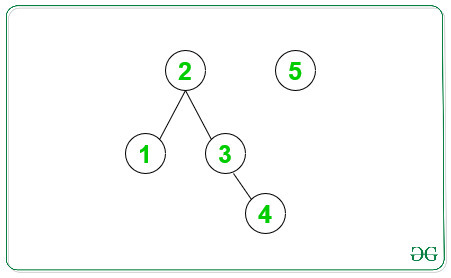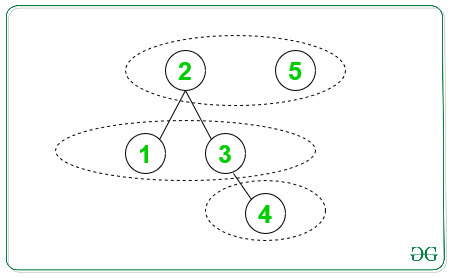给定从1到N的N个顶点的图的邻接表表示,任务是计算给定图的最小二分群。
例子:
Input: N = 5
Below is the given graph with number of nodes is 5:

Output: 3
Explanation:
Possible groups satisfying the Bipartite property: [2, 5], [1, 3], [4]
Below is the number of bipartite groups can be formed:

方法:
这个想法是在给定的N个节点图中找到所有连接组件的最大高度,以找到最小的二部组。步骤如下:
- 对于给定图中所有未访问的顶点,从当前顶点开始查找当前连接组件的高度。
- 启动“ DFS遍历”以查找所有已连接组件的高度。
- 计算出的所有连接组件的最大高度给出了所需的最小二部分组。
下面是上述方法的实现:
C++
#include
using namespace std;
// Function to find the height sizeof
// the current component with vertex s
int height(int s, vector adj[],
int* visited)
{
// Visit the current Node
visited[s] = 1;
int h = 0;
// Call DFS recursively to find the
// maximum height of current CC
for (auto& child : adj[s]) {
// If the node is not visited
// then the height recursively
// for next element
if (visited[child] == 0) {
h = max(h, 1 + height(child, adj,
visited));
}
}
return h;
}
// Function to find the minimum Groups
int minimumGroups(vector adj[], int N)
{
// Intialise with visited array
int visited[N + 1] = { 0 };
// To find the minimum groups
int groups = INT_MIN;
// Traverse all the non visited Node
// and calculate the height of the
// tree with current node as a head
for (int i = 1; i <= N; i++) {
// If the current is not visited
// therefore, we get another CC
if (visited[i] == 0) {
int comHeight;
comHeight = height(i, adj, visited);
groups = max(groups, comHeight);
}
}
// Return the minimum bipartite matching
return groups;
}
// Function that adds the current edges
// in the given graph
void addEdge(vector adj[], int u, int v)
{
adj[u].push_back(v);
adj[v].push_back(u);
}
// Drivers Code
int main()
{
int N = 5;
// Adjacency List
vector adj[N + 1];
// Adding edges to List
addEdge(adj, 1, 2);
addEdge(adj, 3, 2);
addEdge(adj, 4, 3);
cout << minimumGroups(adj, N);
} Java
import java.util.*;
class GFG{
// Function to find the height sizeof
// the current component with vertex s
static int height(int s, Vector adj[],
int []visited)
{
// Visit the current Node
visited[s] = 1;
int h = 0;
// Call DFS recursively to find the
// maximum height of current CC
for (int child : adj[s]) {
// If the node is not visited
// then the height recursively
// for next element
if (visited[child] == 0) {
h = Math.max(h, 1 + height(child, adj,
visited));
}
}
return h;
}
// Function to find the minimum Groups
static int minimumGroups(Vector adj[], int N)
{
// Intialise with visited array
int []visited= new int[N + 1];
// To find the minimum groups
int groups = Integer.MIN_VALUE;
// Traverse all the non visited Node
// and calculate the height of the
// tree with current node as a head
for (int i = 1; i <= N; i++) {
// If the current is not visited
// therefore, we get another CC
if (visited[i] == 0) {
int comHeight;
comHeight = height(i, adj, visited);
groups = Math.max(groups, comHeight);
}
}
// Return the minimum bipartite matching
return groups;
}
// Function that adds the current edges
// in the given graph
static void addEdge(Vector adj[], int u, int v)
{
adj[u].add(v);
adj[v].add(u);
}
// Drivers Code
public static void main(String[] args)
{
int N = 5;
// Adjacency List
Vector []adj = new Vector[N + 1];
for (int i = 0 ; i < N + 1; i++)
adj[i] = new Vector();
// Adding edges to List
addEdge(adj, 1, 2);
addEdge(adj, 3, 2);
addEdge(adj, 4, 3);
System.out.print(minimumGroups(adj, N));
}
}
// This code is contributed by 29AjayKumar Python3
import sys
# Function to find the height sizeof
# the current component with vertex s
def height(s, adj, visited):
# Visit the current Node
visited[s] = 1
h = 0
# Call DFS recursively to find the
# maximum height of current CC
for child in adj[s]:
# If the node is not visited
# then the height recursively
# for next element
if (visited[child] == 0):
h = max(h, 1 + height(child, adj,
visited))
return h
# Function to find the minimum Groups
def minimumGroups(adj, N):
# Intialise with visited array
visited = [0 for i in range(N + 1)]
# To find the minimum groups
groups = -sys.maxsize
# Traverse all the non visited Node
# and calculate the height of the
# tree with current node as a head
for i in range(1, N + 1):
# If the current is not visited
# therefore, we get another CC
if (visited[i] == 0):
comHeight = height(i, adj, visited)
groups = max(groups, comHeight)
# Return the minimum bipartite matching
return groups
# Function that adds the current edges
# in the given graph
def addEdge(adj, u, v):
adj[u].append(v)
adj[v].append(u)
# Driver code
if __name__=="__main__":
N = 5
# Adjacency List
adj = [[] for i in range(N + 1)]
# Adding edges to List
addEdge(adj, 1, 2)
addEdge(adj, 3, 2)
addEdge(adj, 4, 3)
print(minimumGroups(adj, N))
# This code is contributed by rutvik_56C#
using System;
using System.Collections.Generic;
class GFG{
// Function to find the height sizeof
// the current component with vertex s
static int height(int s, List []adj,
int []visited)
{
// Visit the current Node
visited[s] = 1;
int h = 0;
// Call DFS recursively to find the
// maximum height of current CC
foreach (int child in adj[s]) {
// If the node is not visited
// then the height recursively
// for next element
if (visited[child] == 0) {
h = Math.Max(h, 1 + height(child, adj,
visited));
}
}
return h;
}
// Function to find the minimum Groups
static int minimumGroups(List []adj, int N)
{
// Intialise with visited array
int []visited= new int[N + 1];
// To find the minimum groups
int groups = int.MinValue;
// Traverse all the non visited Node
// and calculate the height of the
// tree with current node as a head
for (int i = 1; i <= N; i++) {
// If the current is not visited
// therefore, we get another CC
if (visited[i] == 0) {
int comHeight;
comHeight = height(i, adj, visited);
groups = Math.Max(groups, comHeight);
}
}
// Return the minimum bipartite matching
return groups;
}
// Function that adds the current edges
// in the given graph
static void addEdge(List []adj, int u, int v)
{
adj[u].Add(v);
adj[v].Add(u);
}
// Drivers Code
public static void Main(String[] args)
{
int N = 5;
// Adjacency List
List []adj = new List[N + 1];
for (int i = 0 ; i < N + 1; i++)
adj[i] = new List();
// Adding edges to List
addEdge(adj, 1, 2);
addEdge(adj, 3, 2);
addEdge(adj, 4, 3);
Console.Write(minimumGroups(adj, N));
}
}
// This code is contributed by Rajput-Ji 输出:
3
时间复杂度: O(V + E),其中V是顶点数,E是边集。